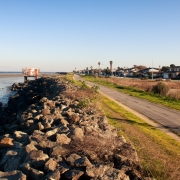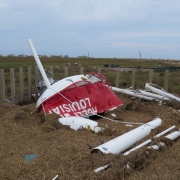High Demand for New Michigan Water Infrastructure Grants
Funding requests are more than three times larger than available funds.

Streets in Parchment, Michigan, near a site where PFAS chemicals contaminated groundwater. Towns like Parchment are eligible for a new state grant to help communities reduce drinking water contamination. Photo © J. Carl Ganter / Circle of Blue
By Brett Walton, Circle of Blue
A new grant program in Michigan to rid drinking water systems of contaminants is proving to be quite popular.
The Michigan Department of Environment, Great Lakes, and Energy announced that 32 grant applicants, many of them small towns, requested more than $80 million in state funds.
The problem? Only $25 million is available to hand out.
“I’d say the takeaway is that there is intense interest in finding solutions to the problem of contaminants in drinking water and a large demand for funding solutions that will ensure all Michiganders have access to clean, safe, affordable water,” Nick Assendelft wrote in an email to Circle of Blue. Assendelft is a spokesperson with the Michigan Department of Environment, Great Lakes, and Energy (EGLE), which is administering the grant program.
The Consolidation and Contamination Risk Reduction grant is part of a $500 million package of clean water initiatives that Gov. Gretchen Whitmer unveiled on October 1. The Michigan Clean Water plan aims to update the state’s drinking water and sewer systems and reduce chemical contamination in drinking water.
The risk reduction grant is a small but important piece of the plan. Communities can use the grant to connect homes with contaminated private wells to public water systems. They can also use the money to install treatment systems.
A priority contaminant is the class of chemicals known as PFAS, which do not easily break down in the environment. A statewide investigation has found 154 sites with at least one PFAS chemical that exceeds state standards. Grant applicants that intend to address PFAS contamination from one of these sites will receive priority when the state determines which projects to fund.
Though PFAS problems are widespread in Michigan, grant applicants are hoping to address other water quality problems, too.
West Branch, a town of about 2,200 people in Ogemaw County, is one of those. Naturally occurring iron and arsenic have troubled the town’s water supply for decades.
John Dantzer, the West Branch city manager, told Circle of Blue that the town drilled two wells in 2009, anticipating that new water sources would solve the problem. They did not.
West Branch applied for $4 million to install equipment to remove iron and arsenic. Getting a grant would be a huge benefit for the town, Dantzer said.
“It’d be a great source to improve the water for residents and businesses in the area,” Dantzer said.
The window for grant applications closed on January 31. Assendelft said that EGLE is now vetting the applications, awarding points for criteria such as the extent of contamination, the number of water quality violations, and the number of PFAS chemicals in the water that exceed state standards. Projects with higher point totals will take priority. Grants are capped at $5 million per applicant.
The department hopes to announce grant recipients in late March at the earliest, Assendelft said.
Brett writes about agriculture, energy, infrastructure, and the politics and economics of water in the United States. He also writes the Federal Water Tap, Circle of Blue’s weekly digest of U.S. government water news. He is the winner of two Society of Environmental Journalists reporting awards, one of the top honors in American environmental journalism: first place for explanatory reporting for a series on septic system pollution in the United States(2016) and third place for beat reporting in a small market (2014). He received the Sierra Club’s Distinguished Service Award in 2018. Brett lives in Seattle, where he hikes the mountains and bakes pies. Contact Brett Walton











Leave a Reply
Want to join the discussion?Feel free to contribute!